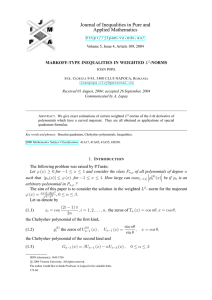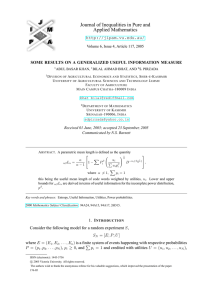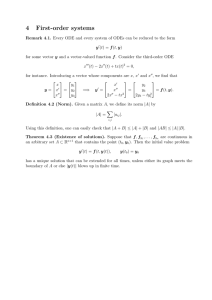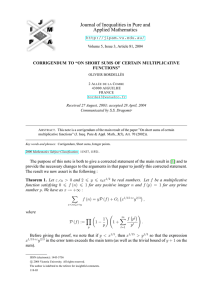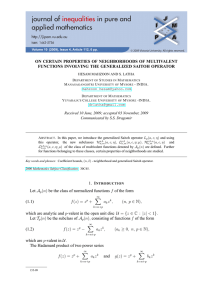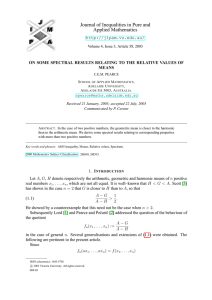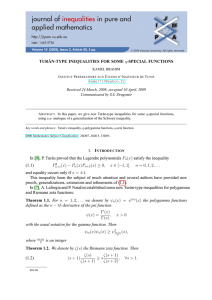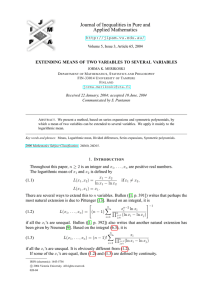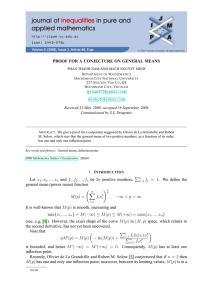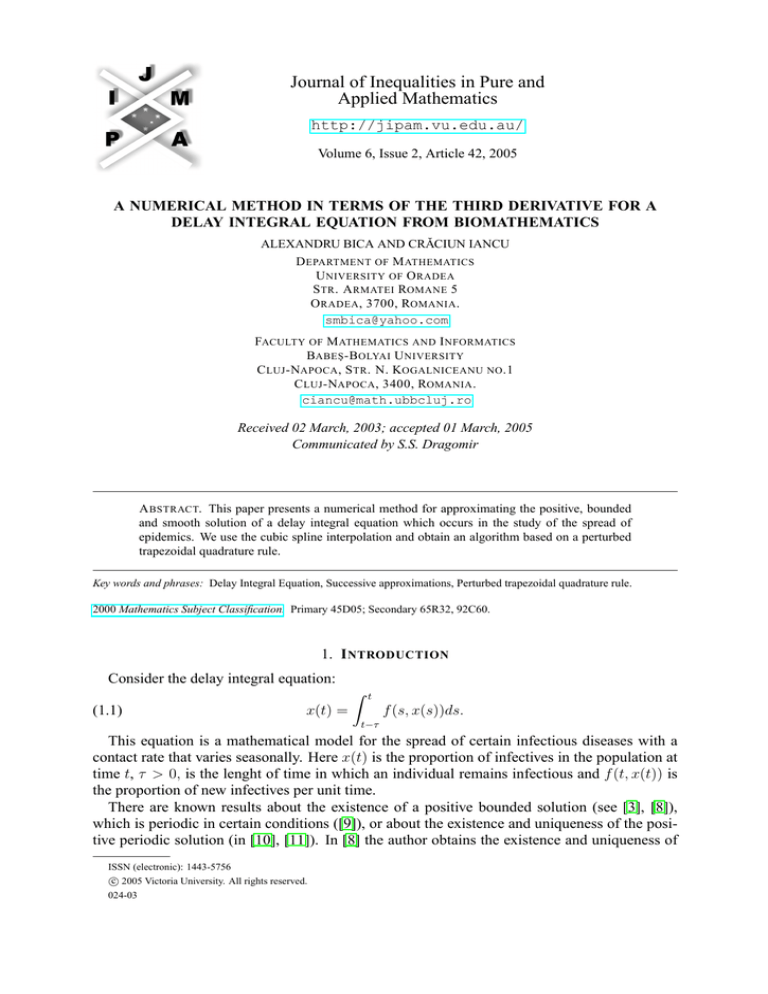
Journal of Inequalities in Pure and
Applied Mathematics
http://jipam.vu.edu.au/
Volume 6, Issue 2, Article 42, 2005
A NUMERICAL METHOD IN TERMS OF THE THIRD DERIVATIVE FOR A
DELAY INTEGRAL EQUATION FROM BIOMATHEMATICS
ALEXANDRU BICA AND CRĂCIUN IANCU
D EPARTMENT OF M ATHEMATICS
U NIVERSITY OF O RADEA
S TR . A RMATEI ROMANE 5
O RADEA , 3700, ROMANIA .
smbica@yahoo.com
FACULTY OF M ATHEMATICS AND I NFORMATICS
BABE Ş -B OLYAI U NIVERSITY
C LUJ -NAPOCA , S TR . N. KOGALNICEANU NO .1
C LUJ -NAPOCA , 3400, ROMANIA .
ciancu@math.ubbcluj.ro
Received 02 March, 2003; accepted 01 March, 2005
Communicated by S.S. Dragomir
A BSTRACT. This paper presents a numerical method for approximating the positive, bounded
and smooth solution of a delay integral equation which occurs in the study of the spread of
epidemics. We use the cubic spline interpolation and obtain an algorithm based on a perturbed
trapezoidal quadrature rule.
Key words and phrases: Delay Integral Equation, Successive approximations, Perturbed trapezoidal quadrature rule.
2000 Mathematics Subject Classification. Primary 45D05; Secondary 65R32, 92C60.
1. I NTRODUCTION
Consider the delay integral equation:
Z
(1.1)
t
x(t) =
f (s, x(s))ds.
t−τ
This equation is a mathematical model for the spread of certain infectious diseases with a
contact rate that varies seasonally. Here x(t) is the proportion of infectives in the population at
time t, τ > 0, is the lenght of time in which an individual remains infectious and f (t, x(t)) is
the proportion of new infectives per unit time.
There are known results about the existence of a positive bounded solution (see [3], [8]),
which is periodic in certain conditions ([9]), or about the existence and uniqueness of the positive periodic solution (in [10], [11]). In [8] the author obtains the existence and uniqueness of
ISSN (electronic): 1443-5756
c 2005 Victoria University. All rights reserved.
024-03
2
A LEXANDRU B ICA AND C R ĂCIUN I ANCU
the continuous positive bounded solution, and in [6] a numerical method for the approximation
of this solution is provided using the trapezoidal quadrature rule.
Here, we obtain the existence and uniqueness of the positive, bounded and smooth solution
and use the cubic spline of interpolation from [5] to approximate this solution on the initial interval [−τ, 0]. We suppose that on [−τ, 0], the solution Φ is known only in the discrete moments
ti , i = 0, n, and use the values Φ(ti ) = yi , i = 0, n for the spline interpolation. Afterward, we
outline a numerical method and an algorithm to approximate the solution on [0, T ], with T > 0
fixed, using the quadrature rule from [1] and [2].
2. E XISTENCE AND U NIQUENESS OF THE P OSITIVE S MOOTH S OLUTION
Impose the initial condition x(t) = Φ(t), t ∈ [−τ, 0] to equation (1.1) and consider T > 0,
be fixed. We obtain the initial value problem:
Rt
t−τ f (s, x(s))ds, ∀t ∈ [0, T ]
(2.1)
x(t) =
Φ(t),
∀t ∈ [−τ, 0].
Suppose that the following conditions are fulfilled:
(i) Φ ∈ C 1 [−τ, 0] and we have
Z 0
0
b = Φ(0) =
f (s, x(s))ds with Φ (0) = f (0, b) − f (−τ, Φ(−τ ));
−τ
(ii) b > 0 and ∃a, M, β ∈ R, M > 0, 0 < a ≤ β such that a ≤ Φ(t) ≤ β, ∀t ∈ [−τ, 0];
(iii) f ∈ C([−τ, T ] × [a, β]), f (t, x) ≥ 0, f (t, y) ≤ M, ∀t ∈ [−τ, T ], ∀x ≥ 0, ∀y ∈
[a, β];
(iv) M τ ≤ β and there is an integrable function g such that f (t, x) ≥ g(t), ∀t ∈ [−τ, T ],
∀x ≥ a and
Z
t
g(s)ds ≥ a,
∀t ∈ [0, T ];
t−τ
(v) ∃L > 0 such that |f (t, x) − f (t, y)| ≤ L |x − y| , ∀t ∈ [−τ, T ], ∀x, y ∈ [a, ∞).
Then, we obtain the following result:
Theorem 2.1. Suppose that assumptions (i)-(v) are satisfied. Then the equation (1.1) has a
unique continuous solution x(t) on [−τ, T ], with a ≤ x(t) ≤ β, ∀t ∈ [−τ, T ] such that x(t) =
Φ(t) for t ∈ [−τ, 0]. Also,
max {|xn (t) − x(t)| : t ∈ [0, T ]} −→ 0
as n → ∞ where xn (t) = Φ(t) for t ∈ [−τ, 0] , n ∈ N , x0 (t) = b and
Z t
xn (t) =
f (s, xn−1 (s))ds
t−τ
∗
for t ∈ [0, T ] , n ∈ N . Moreover, the solution x belongs to C 1 [−τ, T ].
Proof. From [9] under the conditions (i), (ii), (iv), (v), it follows that the existence of an unique
positive continuous on [−τ, T ] solution for (1.1) such that x(t) ≥ a, ∀t ∈ [−τ, T ] and x(t) =
Φ(t) for t ∈ [−τ, 0]. Using Theorem 2 from [7] we conclude that max {|xn (t) − x(t)| : t ∈ [0, T ]}
−→ 0 as n → ∞ . From (iv) we see that
Z t
Z t
x(t) =
f (s, x(s))ds ≤
M ds = M τ ≤ β, ∀t ∈ [0, T ].
t−τ
J. Inequal. Pure and Appl. Math., 6(2) Art. 42, 2005
t−τ
http://jipam.vu.edu.au/
A N UMERICAL M ETHOD
IN
T ERMS OF THE T HIRD D ERIVATIVE
3
Because a ≤ Φ(t) ≤ β for t ∈ [−τ, 0] and x(t) = Φ(t) for t ∈ [−τ, 0] we deduce that
a ≤ x(t) ≤ Rβ, ∀t ∈ [−τ, T ], and the solution is bounded. Since x is a solution for (1.1) we
t
have x(t) = t−τ f (s, x(s))ds, for all t ∈ [0, T ], and because f ∈ C([−τ, T ] × [a, β]) we can
state that x is differentiable on [0, T ] , and x0 is continuous on [0, T ]. From condition (iii) it
follows that x is differentiable with x0 continuous on [−τ, 0] (including the continuity in the
point t = 0). Then x ∈ C 1 [−τ, T ] and the proof is complete.
Corollary 2.2. In the conditions of the Theorem2.1, if f ∈ C 1 ([−τ, T ] × [a, β]), Φ ∈ C 2 [−τ, 0]
and
∂f
∂f
(0, b) +
(0, b) [f (0, b) − f (−τ, , Φ(−τ ))]
∂t
∂x
∂f
∂f
−
(−τ, Φ(−τ )) −
(−τ, Φ(−τ )) Φ0 (−τ ),
∂t
∂x
then x ∈ C 2 [−τ, T ].
Φ00 (0) =
Proof. Follows directly from the above theorem.
3. A PPROXIMATION OF THE S OLUTION ON THE I NITIAL I NTERVAL
Suppose that on the interval [−τ, 0] the function Φ is known only in the points, ti , i = 0, n,
which form the uniform partition
∆n : −τ = t0 < t1 < · · · < tn−1 < tn = 0,
(3.1)
where we have the values Φ(ti ) = yi , i = 0, n and ti+1 − ti = h = nτ , ∀i = 0, n − 1.
Let
1
∆2 y0 ∆3 y0 ∆4 y0
∆y0 −
+
−
, and
m0 =
h
2
3
4
11∆4 y0
1
2
3
M0 = 2 ∆ y 0 − ∆ y0 +
,
h
12
where,
∆y0 = y1 − y0 ,
∆2 y0 = y2 − 2y1 + y0 ,
∆3 y0 = y3 − 3y2 + 3y1 − y0 ,
∆4 y0 = y4 − 4y3 + 6y2 − 4y1 + y0 .
We build a cubic spline of interpolation which corresponds to the following conditions:
Φ(ti ) = yi , i = 0, n,
(3.2)
0
Φ (t0 ) = m0 ,
00
Φ (t0 ) = M0 .
This spline function is s ∈ C 2 [−τ, 0] which, according to [5], have on the each subinterval
[ti−1 , ti ], i = 1, n, the expression:
(3.3)
s(t) =
Mi − Mi−1
Mi−1
· (t − ti−1 )3 +
· (t − ti−1 )2 + mi−1 · (t − ti−1 ) + yi−1 ,
6hi
2
for t ∈ [ti−1 , ti ] where yi = s(ti ), mi = s0 (ti ), Mi = s00 (ti ), i = 0, n. For these values,
according to [5], there exists the recurence relations:
yi − yi−1 6mi−1
−
− 2Mi−1
Mi = 6 ·
h2
h
(3.4)
, i = 1, n.
yi − yi−1
1
mi = 3 ·
− 2mi−1 − Mi−1 · h
h
2
J. Inequal. Pure and Appl. Math., 6(2) Art. 42, 2005
http://jipam.vu.edu.au/
4
A LEXANDRU B ICA AND C R ĂCIUN I ANCU
Then, from [5] Lemma 2.1, there exists a unique cubic spline function of interpolation, s,
which satisfy the conditions:
s(ti ) = yi , ∀i = 0, n
s0 (t0 ) = m0
(3.5)
00
s (t0 ) = M0 ,
and on the each subinterval of ∆n is defined by the relation (3.3).
Between the values of s0 and s00 on the knots there exists the relations:
yi − yi−1 − mi−1 · h
M
+
2M
=
6
·
i
i−1
h2
, i = 1, n.
(3.6)
2
(m
−
m
)
i
i−1
Mi + Mi−1 =
h
This spline function s approximates the solution Φ on the interval [−τ, 0] and we have s(ti ) =
Φ(ti ) = yi , ∀i = 0, n.
Remark 3.1. Since Φ ∈ C 2 [−τ, 0], we can estimate the error of this approximation, kΦ − sk,
where k·k is the Čebyšev norm on the set of continuous functions on an compact interval of the
real axis: kuk = max{|u(t)| : t lies in an compact interval}, for any continuous function u on
R
21
0
this interval. If we know the value kΦ00 k2 = −τ [Φ00 (t)]2 dt , then for each t ∈ [−τ, 0] we
have
√
3
3
|Φ(t) − s(t)| ≤ kΦ − sk ≤ kΦ00 k2 · h 2 ≤ 2 τ kΦ00 k · h 2 ,
according to [4] page 127. Else, if we know only the values yi = Φ(ti ), i = 0, n then
|Φ(t) − s(t)| ≤ kΦ − sk , ∀t ∈ [−τ, 0], and for kΦ − sk we use the error estimation from
[7], since Φ ∈ C 2 [−τ, 0] and then Φ is a Lipschitzian function on [−τ, 0].
In [7], it has been shown that
kΦ − sk ≤ max{ks − F1 k , ks − F2 k}
where
ks − F1 k = max{ai : i = 1, n}
ks − F2 k = max{bi : i = 1, n}
and
ai = (s − F1 ) |[ti−1 ,ti ] ,
bi = (s − F2 ) |[t ,t ] ,
i−1 i
F1 (t) = sup{Φ(tk ) − kΦkL · |t − tk | : k = 0, n},
F2 (t) = inf{Φ(tk ) + kΦkL · |t − tk | : k = 0, n},
with
kΦ |∆n kL = max{| [ti−1 , ti ; Φ] |: i = 1, n}
if [ti−1 , ti ; Φ] = [Φ(ti ) − Φ(ti−1 )]/(ti − ti−1 ) is the divided difference of the function Φ on the
knots ti−1 , ti .
J. Inequal. Pure and Appl. Math., 6(2) Art. 42, 2005
http://jipam.vu.edu.au/
A N UMERICAL M ETHOD
IN
T ERMS OF THE T HIRD D ERIVATIVE
5
4. M AIN R ESULTS
From Theorem 2.1 follows that the equation (1.1) has a unique positive, bounded and smooth
solution on [−τ, T ]. Let ϕ be this solution, which, by virtue of Theorem 2.1, can be obtained
by successive approximations method on [0, T ].
So, we have :
ϕm (t) = Φ(t) , for t ∈ [−τ, 0], ∀m ∈ N and
R0
ϕ0 (t) = Φ(0) = b = −τ f (s, Φ(s))ds,
Rt
Rt
ϕ1 (t) = t−τ f (s, ϕ0 (s))ds = t−τ f (s, b)ds,
(4.1)
, for t ∈ [0, T ].
···
Rt
ϕ
m (t) = t−τ f (s, ϕm−1 (s))ds,
···
To obtain the sequence of successive approximations (4.1 ) we compute the integrals using a
quadrature rule.
We assume that there is l ∈ N∗ such that T = lτ. On each interval [iτ, (i + 1)τ ], i = 0, l − 1
we establish an equidistant partition. Then on the interval [−τ, T ] we have q = l · n + n + 1
knots which realize the division:
(4.2)
−τ = t0 < t1 < · · · < tn−1 < 0 = tn < tn+1 < · · · < tq−1 < tq = T,
having ti+1 − ti = h, ∀i = n, q − 1. We can see that tj − τ = tj−n , ∀j = n, q.
In the aim to compute the integrals from (4.1) we use the following quadrature rule of N.S.
Barnett and S.S. Dragomir in [1]:
Z b
n−1
(b − a)2 0
(b − a) X
(4.3)
F (t)dt =
[F (ti ) + F (ti+1 )] −
[F (a) − F 0 (b)] + Rn (F ),
2
2n
12n
a
i=0
where
ti = a + i ·
b−a
,
n
i = 0, n,
and
(b − a)4
· kF 000 k , if F ∈ C 3 [a, b].
160n3
Here, we consider the function F defined by F (t) = f (t, x(t)), for t ∈ [−τ, T ]. Since the
solution of (2.1) verify the relation,
|Rn (F )| ≤
x0 (t) = f (t, x(t)) − f (t − τ, x(t − τ )),
∀t ∈ [0, T ],
we point out the following connection between the smoothness of x and f.
Remark 4.1. In the conditions of Corollary 2.2, if Φ ∈ C 3 [−τ, 0] , f ∈ C 2 ([−τ, T ] × [a, β]),
and
d ∂f
∂f
000
Φ (0) = lim
(t, ϕ(t)) +
(t, ϕ(t))ϕ0 (t)
t>0,t→0 dt
∂t
∂x
∂f
∂f
0
−
(t − τ, ϕ(t − τ )) −
(t − τ, ϕ(t − τ )) ϕ (t − τ ) ,
∂t
∂x
then x ∈ C 3 [−τ, T ].
J. Inequal. Pure and Appl. Math., 6(2) Art. 42, 2005
http://jipam.vu.edu.au/
6
A LEXANDRU B ICA AND C R ĂCIUN I ANCU
If x ∈ C 3 [−τ, T ] and f ∈ C 3 ([−τ, T ]×[a, β]) then F ∈ C 3 [−τ, T ] and F 000 (t) = [f (t, x(t))]000
t ,
∀t ∈ [−τ, T ]. For this function F we apply the quadrature rule (4.3) and obtain the approximative values of the solution ϕ at the points tk , k = n + 1, q, as in the following formula:
Z tk
(4.4) ϕm (tk ) =
f (s, ϕm−1 (s))ds
tk −τ
n−1
=
τ X
[f (tk+i − τ, ϕm−1 (tk+i − τ )) + f (tk+i+1 − τ, ϕm−1 (tk+i+1 − τ ))]
2n i=0
τ 2 ∂f
−
(tk , ϕm−1 (tk ))
12n2 ∂t
∂f
∂f
(tk , ϕm−1 (tk )) · ϕ0m−1 (tk ) −
(tk − τ, ϕm−1 (tk − τ ))
+
∂x
∂t
∂f
(n)
0
− (tk − τ, ϕm−1 (tk − τ )) · ϕm−1 (tk − τ ) + rm,k (f ),
∂x
∀ m ∈ N∗ and ∀k = n + 1, q, where,
ϕ0m−1 (t) = f (t, ϕm−2 (t)) − f (t − τ, ϕm−2 (t − τ )),
∀t ∈ [0, T ], ∀m ∈ N, m ≥ 2,
and ϕ00 (t) = 0, ϕ01 (t) = f (t, b) − f (t − τ, b), ∀t ∈ [0, T ].
To estimate the remainder we need to obtain an upper bound for the third derivative [f (t, x(t))]000
t .
After elementary calculus we have for t ∈ [−τ, T ]:
[f (t, x(t))]000
t =
∂3f
∂3f
(t,
x(t))
+
3
(t, x(t)) · x0 (t)
∂t3
∂t2 ∂x
∂3f
∂3f
2
3
0
+3
(t,
x(t))
·
[x
(t)]
+
(t, x(t)) [x0 (t)]
∂t∂x2
∂x3
∂2f
∂f
∂2f
(t, x(t))x00 (t) + 3 2 (t, x(t))x0 (t)x00 (t) +
(t, x(t))x000 (t).
+3
∂t∂x
∂x
∂x
We denote
M0 = M = max {|f (t, x)| : t ∈ [−τ, T ], x ∈ [a, β]}
|α|
∂αf = max ∂ f (t, x) : t ∈ [−τ, T ], x ∈ [a, β], α1 + α2 = |α|
∂tα1 ∂xα2 ∂tα1 ∂xα2 ∂f ∂f M1 = max ∂t , ∂x ,
2 2 2 ∂ f ∂ f ∂ f M2 = max ∂t2 , ∂t∂x , ∂x2 ,
3 3 3 3 ∂ f ∂ f ∂ f ∂ f M3 = max ∂t3 , ∂t2 ∂x , ∂t∂x2 , ∂x3 .
Consequently, we obtain the estimations:
[f (t, x(t)]000 ≤ M3 (1 + 6M0 + 12M02 + 8M03 )
t
+ M2 (8M1 + 32M0 M1 + 32M02 M1 )
+ 4M13 + 8M0 M3 = M 000 ,
J. Inequal. Pure and Appl. Math., 6(2) Art. 42, 2005
∀t ∈ [−τ, T ],
http://jipam.vu.edu.au/
A N UMERICAL M ETHOD
IN
T ERMS OF THE T HIRD D ERIVATIVE
7
and
τ 4 M 000
(n)
,
∀m ∈ N∗ , ∀k = n + 1, q.
rm,k (f ) ≤
160n3
Then, to compute the integrals (4.1), we can use the following algorithm:
n−1
τ X
[f (tk+i − τ, ϕ0 (tk+i − τ )) + f (tk+i+1 − τ, ϕ0 (tk+i+1 − τ ))]
ϕ1 (tk ) =
2n i=0
∂f
τ 2 ∂f
(t
,
ϕ
(t
))
+
(tk , ϕ0 (tk )) · ϕ00 (tk )
−
k
0
k
2
12n ∂t
∂x
∂f
∂f
(n)
0
−
(tk − τ, ϕ0 (tk − τ )) −
(tk − τ, ϕ0 (tk − τ )) · ϕ0 (tk − τ ) + r1,k (f )
∂t
∂x
(n)
=: ϕ
f1 (tk ) + r1,k (f ),
(4.5) ϕ2 (tk )
n−1
τ X
=
[f (tk+i − τ, ϕ1 (tk+i − τ )) + f (tk+i+1 − τ, ϕ1 (tk+i+1 − τ ))]
2n i=0
τ 2 ∂f
∂f
−
(tk , ϕ1 (tk )) +
(tk , ϕ1 (tk )) · ϕ01 (tk )
2
12n ∂t
∂x
∂f
∂f
(n)
0
− (tk − τ, ϕ1 (tk − τ )) −
(tk − τ, ϕ1 (tk − τ )) · ϕ1 (tk − τ ) + r1,k (f )
∂t
∂x
n−1
τ Xh
(n)
=
f (tk+i − τ, ϕ
f1 (tk+i − τ ) + r1,k+i−n (f ))
2n i=0
i
(n)
+ f (tk+i+1 − τ, ϕ
f1 (tk+i+1 − τ ) + r1,k+i+1−n (f ))
∂f
τ2
(n)
·
(tk , ϕ
f1 (tk ) + r1,k (f ))
−
2
12n
∂t
∂f
(n)
+
(tk , ϕ
f1 (tk ) + r1,k (f )) · (f (tk , b) − f (tk − τ, b))
∂x
∂f
(n)
−
(tk − τ, ϕ
f1 (tk − τ ) + r1,k−n (f ))
∂t
∂f
(n)
(n)
− (tk − τ, ϕ
f1 (tk − τ ) + r1,k−n (f ))(f (tk − τ, b) − f (tk − 2τ, b)) + r2,k (f )
∂x
n−1
τ X
=
[f (tk+i − −τ, ϕ
f1 (tk+i − τ )) + f (tk+i+1 − τ, ϕ
f1 (tk+i+1 − τ ))]
2n i=0
τ2
∂f
∂f
−
·
(tk , ϕ
f1 (tk )) +
(tk , ϕ
f1 (tk )) · (f (tk , b) − f (tk − τ, b))
2
12n
∂t
∂x
∂f
−
(tk − τ, ϕ
f1 (tk − τ ))
∂t
∂f
^
(n)
− (tk − τ, ϕ
f1 (tk − τ )) · (f (tk − τ, b) − f (tk − 2τ, b)) + r2,k (f )
∂x
^
(n)
^
=: ϕ
2 (tk ) + r2,k (f ),
∀k = n + 1, q.
J. Inequal. Pure and Appl. Math., 6(2) Art. 42, 2005
http://jipam.vu.edu.au/
8
A LEXANDRU B ICA AND C R ĂCIUN I ANCU
We have the remainder estimation:
4
000
g
τ 2 M2 (1 + 2M )
r(n) (f ) ≤ τ M
1 + τL +
,
2,k 160n3
6n2
∀k = n + 1, q.
By induction, for m ≥ 3 we obtain:
n−1 τ X
(n) ^
(4.6) ϕm (tk ) =
f (tk+i − τ, ϕ]
m−1 (tk+i − τ ) + rm−1,k+i−n (f ))
2n i=0
i
^
+ f (tk+i+1 − τ, ϕ]
]
m−1 (tk+i+1 − τ, ϕ
m−1 (tk+i+1 − τ ) + rm−1,k+i+1−n (f ))
∂f
τ2
∂f
^
(n)
−
·
(tk , ϕ]
(tk , ϕ]
m−1 (tk ) + rm−1,k (f )) +
m−1 (tk )
2
12n
∂t
∂x
∂f
^
^
(n)
(n)
+ rm−1,k (f )) · ϕ0m−1 (tk ) −
(tk − τ, ϕ]
m−1 (tk − τ ) + rm−1,k−n (f ))
∂t
∂f
^
(n)
0
− (tk − τ, ϕ]
m−1 (tk − τ ) + rm−1,k−n (f )) · ϕm−1 (tk − τ )
∂x
n−1 τ X
(n) ^
f (tk+i − τ, ϕ]
=
m−1 (tk+i − τ ) + rm−1,k+i−n (f ))
2n i=0
i
^
+f (tk+i+1 − τ, ϕ]
m−1 (tk+i+1 − τ ) + rm−1,k+i+1−n (f ))
τ2
∂f
∂f
^
(n)
−
·
(tk , ϕ]
(tk , ϕ]
m−1 (tk ) + rm−1,k (f )) +
m−1 (tk )
2
12n
∂t
∂x
^
^
(n)
(n)
+ rm−1,k (f )) · (f (tk , ϕ]
m−2 (tk ) + rm−2,k (f ))
∂f
^
(n)
− f (tk − τ, ϕ]
(tk − τ, ϕ]
m−2 (tk − τ ) + rm−2,k−n (f )) −
m−1 (tk − τ )
∂t
∂f
^
(n)
+ rm−1,k−n (f )) −
(tk − τ, ϕ]
m−1 (tk − τ )
∂x
^
^
(n)
(n)
+ rm−1,k−n (f )) · (f (tk − τ, ϕ]
m−2 (tk − τ ) + rm−2,k−n (f ))
^
(n)
(n)
− f (tk − 2τ, ϕ]
m−2 (tk − 2τ ) + rm−2,k−2n (f ))) ] + rm,k (f )
n−1
τ X
=
f tk+i − τ, ϕ]
]
m−1 (tk+i − τ ) + f tk+i+1 − τ, ϕ
m−1 (tk+i+1 − τ )
2n i=0
∂f
τ2
∂f
−
·
t
,
ϕ
]
(t
)
+
t
,
ϕ
]
(t
)
·
(f
t
,
ϕ
]
(t
)
k
m−1
k
k
m−1
k
k
m−2
k
12n2
∂t
∂x
∂f
− f (tk − τ, ϕ]
tk − τ, ϕ]
m−2 (tk − τ )) −
m−1 (tk − τ )
∂t
∂f
−
tk − τ, ϕ]
]
m−1 (tk − τ ) · (f (tk − τ ), ϕ
m−2 (tk − τ )
∂x
^
(n)
− f tk − 2τ, ϕ]
m−2 (tk − 2τ ) ) +rm,k (f )
^
(n)
=: ϕf
m (tk ) + rm,k (f ),
J. Inequal. Pure and Appl. Math., 6(2) Art. 42, 2005
http://jipam.vu.edu.au/
A N UMERICAL M ETHOD
IN
T ERMS OF THE T HIRD D ERIVATIVE
9
∀m ∈ N , m ≥ 2 , ∀k = n + 1, q.
Remark 4.2. We can see that, for k = n, 2n we have tk − τ ∈ [−τ, 0] and then
ϕ0m−1 (tk − τ ) = Φ0 (tk − τ ) = s0 (tk − τ ) = mk−n
for m ∈ N, m ≥ 2 in (4.5) and (4.6).
For the remainders we have the estimations:
g
τ 4 M 000 ^
τ 2 M2 (1 + 2M )
(n)
(n)
(4.7)
rm,k (f ) ≤ 160n3 + rm−1,k (f ) · τ L +
6n2
^
τ 2 LM2 ^
(n)
(n)
+
rm−1,k (f ) · rm−2,k (f )
2
3n
τ 4 M 000
m−1 m−1
1
+
τ
L
+
...
+
τ
L
160n3
τ m Lm−2 M2 · (2M + 1) τ 4 M 000
1
+
·
+O
2
3
6n
160n
n5
1
τ 4 M 000 (1 − τ m Lm ) τ 6 M 000 τ m−2 Lm−2 M2 · (2M + 1)
+
+
O
,
=
160n3 (1 − τ L)
960n5
n5
≤
∀m ∈ N, m ≥ 3, ∀k = n + 1, q.
For instance, if m = 3 we have the estimation:
^
τ 4 M 000
(n)
(4.8) r3,k (f ) ≤
1 + τ L + τ 2 L2
3
160n
τ 6 M 000 M2 · (1 + 2τ L) (2M + 1) τ 8 M 000 M22 · (2M + 1)2
+
+
960n5
5760n7
10
000 2
12
τ (M ) M2 L · (1 + τ L) τ (M 000 )2 M22 L · (2M + 1)
+
,
+
76800n8
460800n10
∀k = n + 1, q.
We obtain the following result:
Theorem 4.3. Considering the initial value problem (2.1) under the conditions from Corollary
2.2 and Remark 4.1, if f ∈ C 3 ([−τ, T ] × [a, β]) , τ L < 1 and the exact solution ϕ is approximated by the sequence (ϕf
m (tk ))k∈N∗ , k = 1, q , on the equidistant points (3.1), through
the successive approximation method (4.1), combined with the quadrature rule (4.3), then the
following error estimation holds :
(4.9)
|ϕ(tk ) − ϕf
m (tk )| ≤
τ m · Lm
τ 4 M 000
· kϕ0 − ϕ1 kC[0,T ] +
1 − τL
160n3 (1 − τ L)
τ 6 M 000 τ m−2 Lm−2 M2 · (2M + 1)
1
+
+
O
,
960n5
n5
∀m ∈ N∗ , m ≥ 2, ∀k = n + 1, q.
Proof. We have
∗
|ϕ(tk ) − ϕf
f
m (tk )| ≤ |ϕ(tk ) − ϕm (tk )| + |ϕm (tk ) − ϕ
m (tk )| , ∀m ∈ N , ∀k = n, q.
From Banach’s fixed point principle we have
|ϕ(tk ) − ϕm (tk )| ≤ kϕ − ϕm k ≤
J. Inequal. Pure and Appl. Math., 6(2) Art. 42, 2005
τ m · Lm
· kϕ0 − ϕ1 kC[0,T ] ,
1 − τL
http://jipam.vu.edu.au/
10
A LEXANDRU B ICA AND C R ĂCIUN I ANCU
∀m ∈ N∗ , ∀k = n + 1, q. Also,
g
(n)
|ϕm (tk ) − ϕf
m (tk )| ≤ rm,k (f ) ,
∀m ∈ N∗ , m ≥ 2, ∀k = n + 1, q.
Using the remainder estimation (4.7), the proof is completed.
If F 000 is Lipschitzian we can use a recent formula of N.S. Barnett and S.S. Dragomir from
Corollary 1 in [2],
Z b
(b − a)2 0
(b − a)
[F (a) + F (b)] −
[F (b) − F 0 (a)] + R(F ),
F (t)dt =
2
12
a
5
with |R(F )| ≤ L(b−a)
, where L is the Lipschitz constant. A composite quadrature formula
720
can be easy obtained, considering an uniform partition of [a, b] with the knots ti = a + i · b−a
,
n
b−a
i = 0, n and the step h = n ,
Z b
n−1
(b − a) X
(b − a)2 0
F (t)dt =
[F (ti ) + F (ti+1 )] −
[F (a) − F 0 (b)] + Rn (F ),
2
2n i=0
12n
a
having the remainder estimation,
L (b − a)5
.
720n4
Here, we use these formulas for F (t) = f (t, x(t)) and obtain,
Z tk
Z tk
(4.10)
f (t, x(t))dt =
F (t)dt
|Rn (F )| ≤
tk −τ
tk −τ
n−1
τ X
[F (tk+i − τ ) + F (tk+i+1 − τ )]
=
2n i=0
−
τ2
[F 0 (tk ) − F 0 (tk − τ )] + Rn (F ),
12n2
∀k = n + 1, q.
with
τ 5 L3
,
720n4
if ∃L3 > 0 such that |F 000 (u) − F 000 (v)| ≤ L3 |u − v| , ∀u, v ∈ [−τ, T ]. From (4.7) and (4.3)
we see that the relations (4.5) and (4.6) remains unchanged in this case, and for the remainders
the estimations (4.7) becomes:
τ 5 L3
(n) ,
∀k = n + 1, q
r1,k (f ) ≤
720n4
5
2
g
τ
L
τ
M
(1
+
2M
)
3
2
(n)
r (f ) ≤
,
∀k = n + 1, q
2,k 720n4 1 + τ L +
6n2
g
^
τ 5 L3
τ 2 M2 (1 + 2M )
(n)
(n)
(4.11)
rm,k (f ) ≤ 720n4 + rm−1,k (f ) · τ L +
6n2
^
τ 2 LM2 ^
(n)
(n)
· r
+
r
(f
)
(f
)
m−1,k
m−2,k
3n2
τ 5 L3 (1 − τ m Lm ) τ 7 L3 τ m−2 Lm−2 M2 · (2M + 1)
1
≤
+
+O
,
4
6
720n (1 − τ L)
4320n
n6
|Rn (F )| ≤
∀m ∈ N∗ , ∀k = n + 1, q.
J. Inequal. Pure and Appl. Math., 6(2) Art. 42, 2005
http://jipam.vu.edu.au/
A N UMERICAL M ETHOD IN T ERMS OF THE T HIRD D ERIVATIVE
11
For instance, the estimation (4.8) becomes:
5
2
2
g
g
g
τ
L
τ
LM
τ
M
(1
+
2M
)
2
3
2
(n)
(n)
(n)
r (f ) ≤
r (f ) · τ L +
r (f ) · r(n) (f )
+
+
3,k 720n4 2,k 6n2
3n2 2,k 1,k
τ 5 L3
2 2
≤
1
+
τ
L
+
τ
L
720n4
τ 7 L3 M2 · (1 + 2τ L) (2M + 1) τ 9 L3 M22 · (2M + 1)2
+
+
4320n6
25920n8
14
2
2
12
2
τ (L3 ) M2 L · (1 + τ L) τ (L3 ) M2 L · (2M + 1)
+
+
, ∀k = n + 1, q.
1825200n10
10951200n12
In this way we obtain the following result:
Theorem 4.4. If f ∈ C 3 ([−τ, T ] × [α, β]), Φ ∈ C 3 [−τ, 0], having,
d ∂f
∂f
000
Φ (0) = lim
(t, ϕ(t)) +
(t, ϕ(t))ϕ0 (t)
t>0,t→0 dt
∂t
∂x
∂f
∂f
0
−
(t − τ, ϕ(t − τ )) −
(t − τ, ϕ(t − τ )) ϕ (t − τ ) ,
∂t
∂x
3
3
3
∂ f
∂ f
3
000
and the functions ∂∂t3f , ∂t∂x
is
2 and ∂x3 are Lipschitzian in t and x, then ϕ ∈ C [−τ, T ], F
Lipschitzian with a Lipschitz constant L3 > 0 and the following estimation holds:
|ϕ(tk ) − ϕf
m (tk )| ≤
τ m · Lm
τ 5 L3
· kϕ0 − ϕ1 kC[0,T ] +
1 − τL
160n3 (1 − τ L)
1
τ 7 L3 τ m−2 Lm−2 M2 · (2M + 1)
+O
,
+
6
4320n
n6
∀m ∈ N∗ , m ≥ 2, ∀k = n + 1, q.
Proof. From Remark 4.1, we infer that ϕ ∈ C 3 [−τ, T ] and because f ∈ C 3 ([−τ, T ] × [α, β])
is Lipschitzian in t and x. For this reason there exist
we see that F ∈ C 3 [−τ, T ] and ∂f
∂x
L01 , L001 > 0 such that
∂f
∂f
(u, x) −
≤ L01 |u − v|
(v,
x)
∂x
∂x
∂f
(u, x) − ∂f (u, y) ≤ L001 |x − y| ,
∂x
∂x
3
∀u, v ∈ [−τ, T ], ∀x, y ∈ [α, β]. Since ∂∂t3f is Lipschitzian in t and x there exist L30 , L030 > 0
such that
3
3
∂ f
∂
f
(u,
x(u))
−
(v,
x(v))
∂t3
∂t3
3
3
∂ f
∂ f
∂3f
∂3f
≤ 3 (u, x(u)) − 3 (v, x(u)) + 3 (v, x(u)) − 3 (v, x(v))
∂t
∂t
∂t
∂t
0
≤ L30 |u − v| + L30 |x(u) − x(v)|
≤ L30 |u − v| + L030 · kx0 k |u − v|
≤ (L30 + 2L030 M ) |u − v| ,
J. Inequal. Pure and Appl. Math., 6(2) Art. 42, 2005
http://jipam.vu.edu.au/
12
A LEXANDRU B ICA AND C R ĂCIUN I ANCU
∀u, v ∈ [−τ, T ]. We have x0 (t) = f (t, x(t)) − f (t − τ, x(t − τ )), ∀t ∈ [0, T ] and kx0 k ≤ 2M.
∂3f
∂3f
0
0
Similar, since ∂t∂x
2 and ∂x3 are Lipschitzian in t and x there exist L12 , L12 > 0 and L03 , L03 > 0
such that we have:
3
∂ f
∂3f
0
0
∂t∂x2 (u, x(u)) − ∂t∂x2 (v, x(v)) ≤ (L12 + L12 · kx k) |u − v| ,
3
3
∂ f
∂
f
≤ (L03 + L003 · kx0 k) |u − v| ,
(u,
x(u))
−
(v,
x(v))
∂x3
3
∂x
∀u, v ∈ [−τ, T ]. Now, we can state that
∂f
∂f
(u, x(u)) −
≤ (L01 + L001 · kx0 k) |u − v| ,
(v,
x(v))
∂x
∂x
∀u, v ∈ [−τ, T ], and since x ∈ C 3 [−τ, T ] we have that x0 and x00 are Lipschitzian. Also, we
have F 000 (t) = [f (t, x(t))]000
t and
[f (t, x(t))]000
t =
∂3f
∂3f
(t,
x(t))
+
3
(t, x(t))x0 (t)
∂t3
∂t2 ∂x
∂3f
∂3f
2
3
0
+3
(t, x(t)) [x (t)] + 3 (t, x(t)) [x0 (t)]
2
∂t∂x
∂x
2
∂2f
∂
f
∂f
+3
(t, x(t))x00 (t) + 3 2 (t, x(t))x0 (t)x00 (t) +
(t, x(t))x000 (t).
∂t∂x
∂x
∂x
From all the above we can see that:
|F 000 (u) − F 000 (v)|
≤ (L30 +
2L030 M ) |u
3 ∂ f 0
− v| + 3 ∂t2 ∂x · kx k |u − v|
2
3
+ 3(L12 + L012 · kx0 k) · kx0 k |u − v| + (L03 + L003 · kx0 k) · kx0 k · |u − v|
2 2 ∂ f · kx000 k |u − v| + 3 ∂ f · kx00 k2 |u − v|
+ 3
∂t∂x ∂x2 + (L01 + L001 · kx0 k) · kx000 k |u − v|
≤ L3 |u − v| ,
∀u, v ∈ [−τ, T ].
Here we have
L3 =L30 + 2L030 M + 6M1 M3 (2M + 1) + 12M 2 (L12 + 2L012 M )
+ 8M 3 (L03 + 2L003 M ) + 6M2 (2M + 1) M2 (2M + 1) + 2M12
+ 12M2 M12 (2M + 1)2 + 2(L01 + 2L001 M )(2M + 1)[M2 (2M + 1) + 2M12 ] > 0,
since kx00 k ≤ 2M1 (2M + 1) and kx00 k ≤ 2(2M + 1)[M2 (2M + 1) + 2M12 ], having for t ∈ [0, T ]
x00 (t) =
∂f
∂f
(t, x(t)) +
(t, x(t))x0 (t)
∂t
∂x
∂f
∂f
−
(t − τ, x(t − τ )) −
(t − τ, x(t − τ )) x0 (t − τ ),
∂t
∂x
J. Inequal. Pure and Appl. Math., 6(2) Art. 42, 2005
http://jipam.vu.edu.au/
A N UMERICAL M ETHOD IN T ERMS OF THE T HIRD D ERIVATIVE
13
and
x000 (t) =
∂2f
∂2f
(t,
x(t))
+
(t, x(t))x0 (t)
∂t2
∂t∂x
2
∂ f
∂2f
0
0
+ x (t) ·
(t, x(t)) + 2 (t, x(t))x (t)
∂t∂x
∂x
2
∂2f
∂f
∂ f
+ x00 (t) (t, x(t)) − 2 (t − τ, x(t − τ )) −
(t − τ, x(t − τ )) · x0 (t − τ )
∂x ∂t
∂t∂x
∂2f
∂2f
0
0
+ x (t − τ ) ·
(t − τ, x(t − τ )) + 2 (t − τ, x(t − τ )) · x (t − τ )
∂t∂x
∂x
∂f
+ x00 (t − τ ) (t − τ, x(t − τ )).
∂x
Then, F 000 is Lipschitzian, and so we can apply the quadrature rule (4.9) from [2] and we have
the inequality (4.11). Using the estimation from Banach’s fixed point principle we obtain the
desired estimation.
Remark 4.5. To approximate the solution ϕ on [0, T ] we can use the cubic spline of interpolation s, defined by the interpolatory conditions:
s(tk ) = ϕf
∀k = n + 1, q
m (tk ),
s(tn ) = yn
00
s (tn ) = Mn = 0, s00 (tq ) = Mq = 0
for a fixed m ∈ N∗ , on the knots tk , k = n, q, as in [4, p. 119–128]:
s : [0, T ] → R, s(t) = si (t), ∀t ∈ [ti−1 , ti ],
∀i = n + 1, q
where,
si (t) =
Mi (t − ti−1 )3 + Mi−1 (ti − t)3 (6ϕi−1 − Mi−1 h2i ) · (ti − t)
+
6hi
6hi
2
(6ϕi − Mi hi ) · (t − ti−1 )
+
, ∀t ∈ [ti−1 , ti ],
6hi
i = n + 1, q,
and ϕk = s(tk ), Mk = s00 (tk ), ∀k = n, q. The values Mk , k = n, q are obtained from the
relations
hi Mi−1 Mi (hi + hi+1 ) hi+1 Mi+1
ϕi+1 − ϕi ϕi − ϕi−1
+
+
=
−
,
6
3
6
hi+1
hi
i = n + 1, q − 1,
where Mn = Mq = 0. Since f ∈ C 3 ([−τ, T ] × [α, β]) we infer that ϕ ∈ C 4 [0, T ]. If Φ ∈
C 4 [−τ, 0] and Φ(0) = lim ϕ(t) then ϕ ∈ C 4 [−τ, T ]. In these hypothesis, for t ∈ [0, T ]\{
t>0,t→0
tk , k = n, q}, we have the following error estimation:
g
τ m · Lm
5 (n)
|ϕ(t) − s(t)| ≤
· kϕ0 − ϕ1 k + rm,k (f ) +
· ϕIV · h4 ,
1 − τL
384
J. Inequal. Pure and Appl. Math., 6(2) Art. 42, 2005
http://jipam.vu.edu.au/
14
A LEXANDRU B ICA AND C R ĂCIUN I ANCU
where h =
T
q−n−1
= nτ . We have
∂3f
∂3f
∂3f
2
0
(t,
x(t))
+
3
(t,
x(t))
·
x
(t)
+
3
(t, x(t)) [x0 (t)]
∂t3
∂t2 ∂x
∂t∂x2
∂3f
∂2f
3
+ 3 (t, x(t)) [x0 (t)] + 3
(t, x(t))x00 (t)
∂x
∂t∂x
∂f
∂2f
+ 3 2 (t, x(t)) · x0 (t) · x00 (t) +
(t, x(t)) · x000 (t)
∂x
∂x
∂3f
∂3f
− 3 (t − τ, x(t − τ )) − 3 2 (t − τ, x(t − τ )) · x0 (t − τ )
∂t
∂t ∂x
∂3f
∂3f
2
3
0
−3
(t
−
τ,
x(t
−
τ
))
·
[x
(t
−
τ
)]
−
(t − τ, x(t − τ )) · [x0 (t − τ )]
2
3
∂t∂x
∂x
2
∂2f
∂
f
−3
(t − τ ))x00 (t − τ ) − 3 2 (t − τ, x(t − τ )) · x0 (t − τ )x00 (t − τ )
∂t∂x
∂x
∂f
−
(t − τ, x(t − τ ))x000 (t − τ ),
∂x
xIV (t) =
∀t ∈ [0, T ]. Since
k f k≤ M,
kϕ0 k ≤ 2M,
kϕ00 k ≤ 2M1 (1 + 2M ),
kϕ000 k ≤ 2M2 (1 + 2M )2 + 4M12 (1 + 2M ),
we have the following estimation:
IV ϕ ≤ 2M3 + 6M3 kϕ0 k + 6M3 kϕ0 k2 + 2M3 kϕ0 k3
+ 6M2 kϕ00 k + 6M2 kϕ0 k · kϕ00 k + 2M1 kϕ000 k
≤ 2M3 (1 + 2M )3 + 16M1 M2 (1 + 2M )2 + 8M13 (1 + 2M ).
R EFERENCES
[1] N.S. BARNETT AND S.S. DRAGOMIR, Perturbed trapezoidal inequality in terms of the third
derivative and applications, RGMIA Res. Rep. Coll., 4(2) (2001), 221–233.
[2] N.S. BARNETT AND S.S. DRAGOMIR, Perturbed trapezoidal inequality in terms of the fourth
derivative and applications, Korean J. Comput. Appl. Math., 9(1) (2002), 45–60.
[3] D. GUO AND V. LAKSMIKANTHAM, Positive solutions of nonlinear integral equations arising
in infectious diseases, J. Math. Anal. Appl., 134 (1988), 1–8.
[4] C. IACOB (Ed.), Classic and Modern Mathematics, Ed. Tehnică, Bucureşti, 1983 (in Romanian).
[5] C. IANCU, On the cubic spline of interpolation, Seminar of Functional Analysis and Numerical
Methods, Cluj-Napoca, Preprint 4, 1981, 52–71.
[6] C. IANCU, A numerical method for approximating the solution of an integral equation from
biomathematics, Studia Univ. "Babeş-Bolyai", Mathematica, XLIII(4) (1998).
[7] C. IANCU AND C. MUSTAŢĂ, Error estimation in the approximation of functions by interpolation
cubic splines, Mathematica- Rev. Anal. Numér. Théor. Approx., 29(52)(1) (1987), 33–39.
[8] R. PRECUP, Positive solutions of the initial value problem for an integral equation modelling infectious diseases, Seminar of Fixed Point Theory, Cluj-Napoca, Preprint 3, 1991, 25–30.
[9] R. PRECUP, Periodic solutions for an integral equation from biomathematics via Leray-Schauder
principle, Studia Univ. ”Babes-Bolyai”, Mathematica, XXXIX(1) (1994).
J. Inequal. Pure and Appl. Math., 6(2) Art. 42, 2005
http://jipam.vu.edu.au/
A N UMERICAL M ETHOD IN T ERMS OF THE T HIRD D ERIVATIVE
15
[10] I.A. RUS, Principles and Applications of the Fixed Point Theory, Ed. Dacia, Cluj-Napoca, 1979 (in
Romanian).
[11] I.A. RUS, A delay integral equation from biomathematics, Seminar of Differential Equations, ClujNapoca, Preprint 3, 1989, 87–90.
J. Inequal. Pure and Appl. Math., 6(2) Art. 42, 2005
http://jipam.vu.edu.au/

